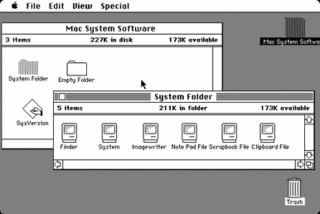
Amiga is a family of personal computers introduced by Commodore in 1985. The original model is one of a number of mid-1980s computers with 16- or 16/32-bit processors, 256 KB or more of RAM, mouse-based GUIs, and significantly improved graphics and audio compared to previous 8-bit systems. These systems include the Atari ST—released earlier the same year—as well as the Macintosh and Acorn Archimedes. Based on the Motorola 68000 microprocessor, the Amiga differs from its contemporaries through the inclusion of custom hardware to accelerate graphics and sound, including sprites and a blitter, and a pre-emptive multitasking operating system called AmigaOS.

An operating system (OS) is system software that manages computer hardware, software resources, and provides common services for computer programs.

Lisa is a desktop computer developed by Apple, released on January 19, 1983. It is one of the first personal computers to present a graphical user interface (GUI) in a machine aimed at individual business users. Its development began in 1978. It underwent many changes before shipping at US$9,995 with a five-megabyte hard drive. It was affected by its high price, insufficient software, unreliable Apple FileWare floppy disks, and the immediate release of the cheaper and faster Macintosh. Only 10,000 were sold in two years.

The Macintosh II is a personal computer designed, manufactured, and sold by Apple Computer from March 1987 to January 1990. Based on the Motorola 68020 32-bit CPU, it is the first Macintosh supporting color graphics. When introduced, a basic system with monitor and 20 MB hard drive cost US$5,498. With a 13-inch color monitor and 8-bit display card the price was around US$7,145. This placed it in competition with workstations from Silicon Graphics, Sun Microsystems, and Hewlett-Packard.

The Apple IIGS, the fifth and most powerful of the Apple II family, is a 16-bit personal computer produced by Apple Computer. While featuring the Macintosh look and feel, and resolution and color similar to the Amiga and Atari ST, it remains compatible with earlier Apple II models. The "GS" in the name stands for "Graphics and Sound," referring to its enhanced multimedia hardware, especially its state-of-the-art audio.

System 7, codenamed "Big Bang", and also known as Mac OS 7, is a graphical user interface-based operating system for Macintosh computers and is part of the classic Mac OS series of operating systems. It was introduced on May 13, 1991, by Apple Computer It succeeded System 6, and was the main Macintosh operating system until it was succeeded by Mac OS 8 in 1997. Current for more than six years, System 7 was the longest-lived major version series of the classic Macintosh operating system. Features added with the System 7 release included virtual memory, personal file sharing, QuickTime, QuickDraw 3D, and an improved user interface.
A desk accessory (DA) in computing is a small transient or auxiliary application that can be run concurrently in a desktop environment with any other application on the system. Early examples, such as Sidekick and Macintosh desk accessories, used special programming models to provide a small degree of multitasking on systems that initially did not have any other multitasking ability.

MacsBug is a low-level debugger for the classic Mac OS operating system). MacsBug is an acronym for Motorola Advanced Computer Systems Debugger, as opposed to Macintosh debugger. The original version was developed by Motorola as a general debugger for its 68000 systems. — it was ported to the Mac as a programmer's tool early in the project's development.
Copland is an operating system developed by Apple for Macintosh computers between 1994 and 1996 but never commercially released. It was intended to be released as System 8, and later, Mac OS 8. Planned as a modern successor to the aging System 7, Copland introduced protected memory, preemptive multitasking, and several new underlying operating system features, while retaining compatibility with existing Mac applications. Copland's tentatively planned successor, codenamed Gershwin, was intended to add more advanced features such as application-level multithreading.
Star Trek is the code name that was given to a secret prototype project, running a port of Macintosh System 7 and its applications on Intel-compatible x86 personal computers. The project, starting in February 1992, was conceived in collaboration between Apple Computer, who provided the majority of engineers, and Novell, who at the time was one of the leaders of cross-platform file-servers. The plan was that Novell would market the resulting OS as a challenge to Microsoft Windows, but the project was discontinued in 1993 and never released, although components were reused in other projects. The project was named after the Star Trek science fiction franchise with the slogan "To boldly go where no Mac has gone before".

The Applix 1616 was a kit computer with a Motorola 68000 CPU, produced by a small company called Applix in Sydney, Australia, from 1986 to the early 1990s. It ran a custom multitasking multiuser operating system that was resident in ROM. A version of Minix was also ported to the 1616, as was the MGR Window System. Andrew Morton, designer of the 1616 and one of the founders of Applix, later became the maintainer of the 2.6 version of the Linux kernel.

A Macintosh clone, also known as a Clonintosh, is a computer running the Mac OS operating system that was not produced by Apple Inc. The earliest Mac clones were based on emulators and reverse-engineered Macintosh ROMs. During Apple's short lived Mac OS 7 licensing program, authorized Mac clone makers were able to either purchase 100% compatible motherboards or build their own hardware using licensed Mac reference designs.
On the classic Mac OS, extensions were small pieces of code that extended the system's functionality. They were run initially at start-up time, and operated by a variety of mechanisms, including trap patching and other code modifying techniques. Initially an Apple developer hack, extensions became the standard way to provide a modular operating system. Large amounts of important system services such as the TCP/IP network stacks and USB and FireWire support were optional components implemented as extensions. The phrase "system extension" later came to encompass faceless background applications as well.

The Motorola 68881 and Motorola 68882 are floating-point units (FPUs) used in some computer systems in conjunction with Motorola's 32-bit 68020 or 68030 microprocessors. These coprocessors are external chips, designed before floating point math became standard on CPUs. The Motorola 68881 was introduced in 1984. The 68882 is a higher performance version produced later.
In computing, preemption is the act of temporarily interrupting an executing task, with the intention of resuming it at a later time. This interrupt is done by an external scheduler with no assistance or cooperation from the task. This preemptive scheduler usually runs in the most privileged protection ring, meaning that interruption and resuming are considered highly secure actions. Such a change in the currently executing task of a processor is known as context switching.
The Amiga computer can be used to emulate several other computer platforms, including legacy platforms such as the Commodore 64, and its contemporary rivals such as the IBM PC and the Macintosh.
The Mac286 was an Intel 80286-based MS-DOS coprocessor expansion card for one of Apple Computer's first expandable Macintosh computers, the 1987 Macintosh II. It was developed by Phoenix Technologies under contract to Apple Computer and sold by AST Research in an effort to close the gap between the Macintosh and IBM PC computing worlds. AST also introduced the related Mac86 card for the Macintosh SE.
The Mac OS nanokernel is an operating system kernel serving as the basis of most PowerPC based system software versions 7 through 9 of the classic Mac OS, predating Mac OS X.

Two major families of Mac operating systems were developed by Apple Inc.

Mac OS is the series of operating systems developed for the Macintosh family of personal computers by Apple Computer from 1984 to 2001, starting with System 1 and ending with Mac OS 9. The Macintosh operating system is credited with having popularized the graphical user interface concept. It was included with every Macintosh that was sold during the era in which it was developed, and many updates to the system software were done in conjunction with the introduction of new Macintosh systems.












